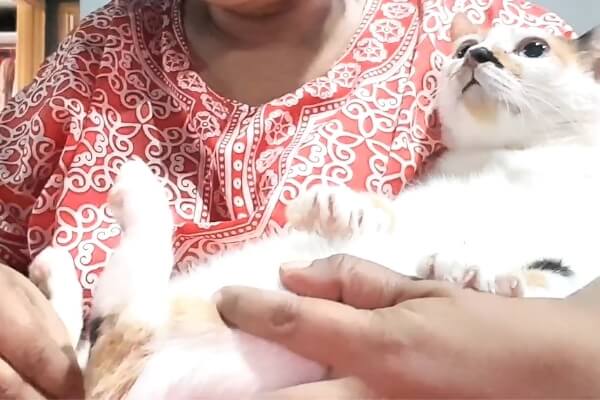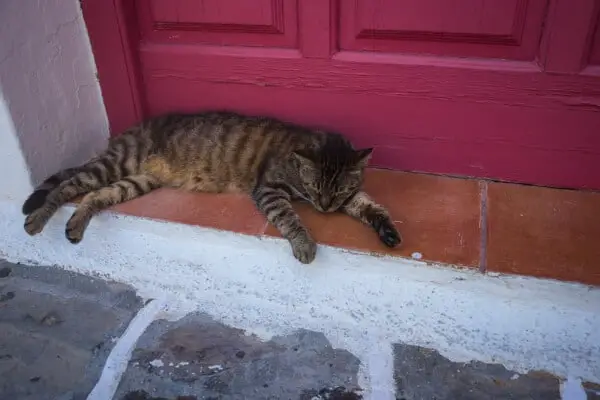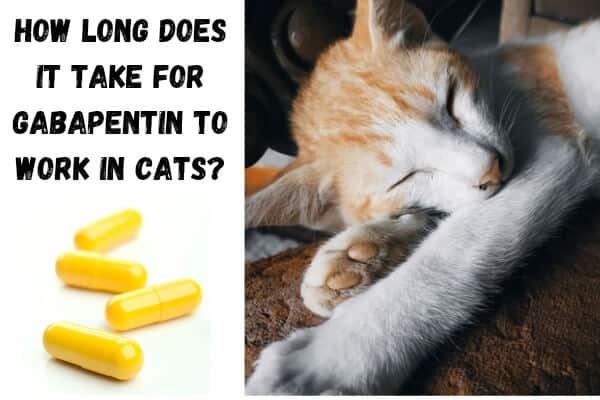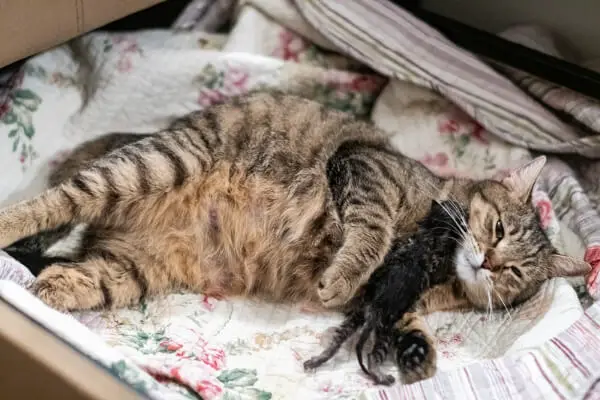How Do Cats Clean Their Bums After Pooping?
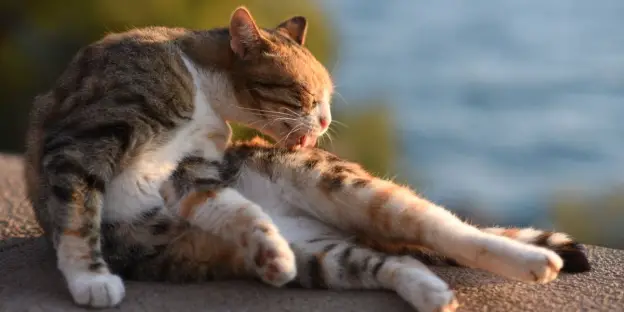
Did you just bring home a cat and are just curious about how cats can groom themselves after going potty or even concerned whether they can effectively groom themselves? Cats are no human but it’s intriguing how they can perfectly groom themselves
Cats are good contortionists. Thanks to their flexible spines, loose skin, and compressible collar bone. They can easily twist and turn their bodies to reach bums. Cats clean their bums after pooping using specially adapted tongues that are covered with tiny, hook-like structures called papillae, to lick their rear ends. Cats also employ their comb-like paws to aid in cleaning hard-to-reach areas.
This process not only ensures hygiene but also serves as a comfort behavior, keeping the cats feeling fresh and comfortable. It’s a natural, instinctual practice that cats undertake from a very young age, a testament to their inherent cleanliness.
Read Also: Kitten Not Cleaning Bum Properly (Reasons & How To Help)
Understanding Cats’ Self-grooming Habits
Cats are fascinating creatures with a wide range of behaviors, many of which serve critical purposes in their daily lives. Among these, their meticulous self-grooming habits stand out.
Primarily, grooming aids in removing debris, parasites, and excessive fur, contributing to a cat’s general hygiene. Additionally, grooming plays a cooling role by spreading saliva that evaporates, lowering the body temperature. The act also promotes blood circulation due to the stimulative effect of the tongue’s movement over the fur. Equally important, grooming helps in stress reduction and fosters social bonding when cats groom each other.
It’s noteworthy that cats dedicate a substantial part of their waking hours—around 30 to 50%—to grooming. Therefore, any abrupt changes in a cat’s grooming habits, such as neglect or over-grooming, could signal health issues requiring veterinary attention.
The parts of a cat’s body involved in grooming are their uniquely adapted tongue and paws, each with a set of features serving specific functions in maintaining cleanliness.
Cats’ Tongue: The surface of a cat’s tongue isn’t smooth as it might seem. Instead, it’s equipped with numerous small, hook-like structures called papillae, composed of keratin—the same material in human nails. The papillae give the tongue a coarse texture akin to sandpaper, a characteristic that is distinctly felt when a cat licks human skin.
The papillae’s unique design contributes significantly to grooming. Their roughness helps in detangling fur, eliminating loose hair, and scrubbing off parasites or dirt lodged in the fur. In addition to grooming, the papillae enhance the cat’s feeding process by enabling efficient meat stripping from bones.
Cats’ Paws: Cats’ paws complement the tongue in grooming, especially for the areas the tongue cannot readily reach. Cats frequently lick their paws, dampening them. The moistened paw is then drawn across the face, ears, or other parts of the body, effectively cleaning and smoothening the fur in these regions.
While the front paws are mainly employed for cleaning smaller regions, such as the face, the back paws are typically used for larger body sections. In the process, the paws clean themselves as well when cats engage in a ‘paw wash.
How Cats Clean Their Bums After Pooping
The cleaning process typically begins shortly after a cat has finished using the litter box. The cat, driven by instinct, will start to clean itself to ensure that it has removed any remnants of waste. This habit dates back to their wild ancestors, where leaving scent traces could potentially attract predators or alert rival cats to their presence.
Cats are renowned for their flexibility and acrobatics prowess which allows them to rotate and extend their bodies far beyond what most animals can. This is possible due to the presence of a flexible backbone and free-floating collar bones They use this flexibility to reach their hindquarters for cleaning. If you’ve ever watched a cat groom, you’ll be familiar with the variety of unusual poses they’ll assume to reach every part of their body.
Cats’ tongues are uniquely designed for grooming. They’re covered in small, hook-like structures made of keratin, known as papillae, which give the tongue a rough texture. This ‘built-in comb’ allows cats to remove dirt and loose fur effectively, and in this case, any remaining feces around the anal area.
However, the tongue isn’t the only tool at a cat’s disposal. Their paws also play a crucial role, particularly in areas that might be more challenging to reach. A cat will often lick its paw until it’s damp, then use the wet paw to wipe around its bum. This action is comparable to us using a wet washcloth.
While the immediate clean-up post-defecation is critical, cats will also frequently clean their bums during their regular grooming sessions throughout the day. This behavior ensures that they maintain a high level of cleanliness, helping to minimize odors and avoid potential skin infections or other health issues
How To Make It Easier For Cats To Clean Their Poop
As pet parents, we’re constantly seeking ways to improve the well-being of our feline friends. Assisting them in maintaining their cleanliness, particularly after defecation, is one area where we can make a significant difference. Here are some practical measures to help your cat keep clean after answering nature’s call.
Dietary Adjustments
What goes in must come out, and the quality of what comes out can greatly affect your cat’s ability to clean up afterward. Cats that eat a well-balanced diet are more likely to have healthy, solid stools that are easier to pass and leave less residue.
However, some diets can cause issues like diarrhea, which complicates a cat’s self-cleaning process. If you notice that your cat’s diet is leading to loose stools, consider changing their food. Consult with your vet for dietary recommendations that suit your cat’s specific needs and age. High-quality cat food that is rich in protein and low in filler can often improve stool consistency.
Weight Management
Obesity can cause several health problems for cats, one of which is a hindrance in their self-grooming process. An overweight cat may struggle to reach its backside, leading to less effective cleaning.
Ensuring that your cat maintains a healthy weight is not just about overall health; it also aids in their grooming efforts. Regular play and exercise combined with portion-controlled feeding can help manage your cat’s weight.
Keep Your Cat Litter Box Clean
A clean litter box is not just pleasant for you; it’s also beneficial for your cat’s hygiene. Cats are naturally clean animals and may avoid a dirty litter box, leading to accidents around the house. Moreover, a clean litter box reduces the chances of waste sticking to your cat’s fur, making their post-pooping cleanup much easier.
Aim to scoop the litter box daily and change the litter entirely at least once a week, or as recommended by the litter manufacturer.
Regular Fur Trimming
Long-haired cats may face extra challenges in keeping their rear end clean due to the added ‘obstacle’ of fur. Regularly trimming the fur around your cat’s bum can help prevent fecal matter from sticking to the fur, making it easier for them to clean up after themselves.
However, it’s crucial to approach this task carefully as the area is sensitive. If you’re uncomfortable doing this, consider seeking the assistance of a professional groomer or vet.
Should I clean my kitten after pooping?
Newborn kittens and those up to about three weeks old are unable to go to the bathroom or clean themselves after pooping without assistance. Their mother would typically stimulate them to go to the bathroom by licking their bottoms and then cleaning up afterward. If the mother cat is not present or unwilling to do this, the responsibility falls to the kitten’s human caregiver. You’ll need to gently stimulate the kitten’s bottom with a warm, damp cloth or cotton ball to encourage them to go to the bathroom, and then clean them up afterward.
By the time kittens reach about a month old, they are generally able to go to the bathroom on their own and will start to develop their grooming habits, including cleaning themselves after pooping. However, these grooming habits may not be fully developed yet, and they might not always do a thorough job.
If you notice that your older kitten has leftover feces on its fur after using the litter box, it’s a good idea to clean them up to prevent any potential hygiene issues. Use a warm, damp cloth or pet-safe wipes to gently clean the area, being careful not to irritate their sensitive skin.
While kittens are learning to groom themselves, it can be beneficial to assist them. Not only does this help keep them clean, but it can also serve as a bonding experience. It’s important to make these cleaning sessions as positive and stress-free as possible to create a positive association with grooming habits.
Is It Okay For My Cat To Lick Its But After Pooping?
Cats are renowned for their fastidious grooming habits. Part of this grooming involves cleaning their anal area after they poop, and they do this by licking it. This behavior is natural and serves an important role in their overall hygiene. By cleaning their bums, cats are able to remove any fecal residue that might be remaining. This helps them stay clean, minimizes unpleasant odors, and can help prevent potential issues such as skin irritation or infections.
The licking action is facilitated by their tongues, which are specially adapted for grooming. A cat’s tongue has tiny, hook-like structures known as papillae. These papillae are oriented backward and give the cat’s tongue a rough texture, similar to a comb or a brush. When a cat licks its fur, these papillae can catch and remove dirt and loose fur.
While this behavior is generally okay and part of a cat’s normal grooming process, it’s important to observe your cat’s behaviors for any changes. If a cat is frequently licking its bum, seems to be uncomfortable, is dragging its bottom along the ground (“scooting”), or if you notice any redness, swelling, or unusual odors, these could be signs of health issues. Problems could include parasites (like worms), blocked or infected anal glands, urinary tract infections, or digestive issues.
Should you notice any such behaviors or symptoms, it’s crucial to contact a vet. They can examine your cat, diagnose any potential issues, and provide appropriate treatment.
When to Seek Professional Help
Conditions such as dental disease, trauma, anxiety, arthritis, obesity, and other illnesses can make grooming difficult, painful, or exhausting for your cat.
As cats age, they may naturally start to groom less. This could be due to a general decrease in energy, the onset of arthritis, or the development of cognitive issues.
A significant change in your cat’s grooming habits is often a sign that something is wrong. If you notice that your cat has stopped grooming, it’s important to consult a veterinarian as soon as possible. A vet can perform a comprehensive examination to identify any underlying health issues and prescribe the necessary treatments or interventions.
In some cases, a professional grooming service may be beneficial, especially if your cat has developed mobility issues. Regular grooming can help keep your cat’s skin and fur healthy, prevent matting and skin infections, and provide an opportunity to spot potential health issues early.
How to teach a kitten to clean its bum
Kittens learn a lot from their mothers, including the art of grooming. But in some instances, you might need to step in to teach your kitten this important self-care routine. Here are some steps to encourage your kitten to clean its bum.
Give Them The Gift Of Time
Patience is a virtue, especially when it comes to teaching kittens new behaviors. As young animals, they’re still figuring out the world around them, and learning to groom properly is part of that process. Give your kitten time to naturally pick up grooming habits. Avoid rushing or forcing them and remember that each kitten develops at their own pace.
Clean Their Bum
While your kitten is still learning, you can help out by keeping their bum clean. Use a warm, damp cloth or pet-safe wipe to gently clean their rear end. This action mimics the cleaning they would receive from their mother and can stimulate their instinct to self-groom. Always approach this delicately to ensure the experience is comfortable, not stressful, for your kitten.
Introduce Scent
Cats have a very developed sense of smell, and scent plays a significant role in their grooming habits. After brushing or cleaning your cat’s bum, take a clean cloth and rub it over areas she frequently grooms (like her face or neck). Then, gently touch the same cloth to her rear end. This can help spread her scent and might encourage her to continue grooming.
Reward Your Cat For Grooming Themselves
Positive reinforcement can go a long way in teaching new behaviors. Whenever you notice your kitten grooming themselves, particularly their bum, reward them with praise, a gentle pet, or a small treat. This helps them associate grooming with positive experiences, encouraging them to continue the behavior.
My Cat Has Poop Stuck To His Fur
There are few things less appealing to pet owners than discovering that their beloved cat has poop stuck to their fur, often referred to as ‘dingleberries’. This is a common issue, particularly in long-haired breeds, and can be caused by a variety of factors, including diet, digestive health, or issues with self-grooming. Here’s how to handle this delicate situation.
First things first, you’ll want to clean your cat’s bum. Wear gloves to maintain hygiene and use a pet-safe wipe, a damp cloth, or baby wipes (unscented and free of harmful chemicals) to gently remove the feces. Be careful not to pull the hair or irritate your cat’s skin. If the poop is hard or matted into the fur, you might need to carefully trim the fur using round-tipped safety scissors. Always move slowly to avoid accidentally cutting your cat’s skin.
Try to figure out why your cat has poop stuck to his bum. A soft stool or diarrhea could mean that feces stick to the fur more readily. If this is the case, it’s worth evaluating your cat’s diet and considering a visit to the vet to rule out health concerns such as parasites or digestive disorders.
Grooming issues can also lead to this problem. Overweight cats, older cats, or those with certain health conditions may struggle to clean their rear end effectively. If you suspect that this is the case, a vet checkup is in order.
Regularly brushing your cat helps to keep their fur from matting, which reduces the chance of feces getting stuck. For long-haired breeds, consider getting the fur around their bum professionally trimmed.
Final Thoughts: How Do Cats Clean Their Bums After Pooping
Cats typically make use of their specially adapted tongues and paws to keep themselves clean, which includes tidying up their rear ends. While this might appear odd to us humans, it is normal and necessary in the feline world.
Nonetheless, certain factors such as obesity, aging, or specific health conditions might make it challenging for some cats to maintain their grooming habits. This is where cat owners can step in and provide support. Strategies like dietary changes, promoting a healthy weight, keeping the litter box in pristine condition, and even regularly trimming the fur near the cat’s backside can assist in facilitating easier self-grooming for your pet.
Cats licking their bums as part of their cleaning routine is natural and generally not harmful. However, it’s essential to stay vigilant and closely observe their grooming patterns. Undergrooming could be a sign of underlying health problems and should be addressed with a veterinarian visit.
Related Articles
Read related posts about


